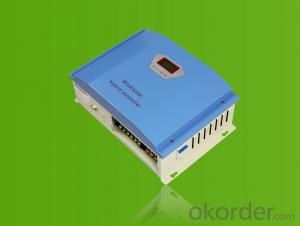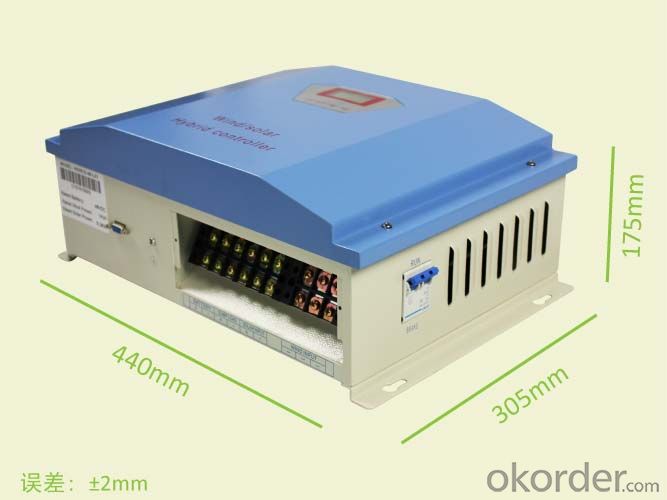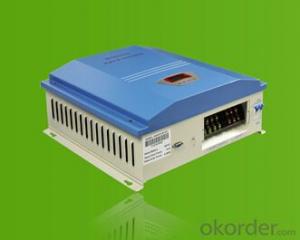Wind Solar Hybrid Controller 10KW PWM Stepless Unload Mode
- Loading Port:
- Shanghai
- Payment Terms:
- TT or LC
- Min Order Qty:
- 1 unit
- Supply Capability:
- 5000 unit/month
OKorder Service Pledge
OKorder Financial Service
You Might Also Like
I. PRODUCT INTRODUCTION
The wind/solar hybrid controller is control device which can control wind turbine and solar panel at the same time and transform wind and solar energy into electricity then store to the battery bank. Wind/solar hybrid controller is the most important part in offgrid system, whose performance has much effect on life expectancy and operational stability of the whole system, especially the battery expectancy. Or battery service life will be shortened by over-charge or over-discharge.
II. PERFORMANCE FEATURES
Superior military-grade components to ensure the product stability.² Perfect protection function, thus the system has higher reliabil ity.
Check and set all operation parameters as requirement from LCD display.
Voltage limiting and current-limiting charge mode ensures battery in the best charging status.
PWM stepless unload mode, which burn the excess power into dump load, making the battery charging in best status.
III. APPLICATION AREAS
Stand alone wind/solar hybrid power station; Stand alone domestic household wind/solar hybrid power system.
Mobile communication base stations, expressway and other non-residential regions.
Coastal islands, remote mountainous, border posts for regions shortage of or without electricity.
Government demonstration projects, landscape lighting project.
IV. 10KW TECHNICAL PARAMETERS
Product Model | WWS100-120 | WWS100-220 | WWS100-240 |
Rated battery voltage | 120 V | 220 V | 240V |
Rated wind turbine input power | 10 kW | 10 kW | 10 kW |
Maximum wind turbine input power | 15 kW | 15 kW | 15 kW |
Wind turbine brake current | 84 A | 46 A | 42 A |
Rated solar input power | 3 kW | 3 kW | 3 kW |
Floating charge voltage | 145 V | 266 V | 290 |
Dimension | Control Box:440×305×170 mm, Dumpload Box:520×430×675 mm | ||
Net Weight | Control Box:9 kg, Dumpload Box:45 kg | ||
Display Mode | LCD | ||
Cooling | Fan | ||
Protection Function | IP20(Indoor) | ||
Quiescent Current | ≤20 mA | ||
Protection Functions | Battery over charge; Battery over discharge; solar reverse charge protection; anti-reverse-connection protection; wind turbine over rotate speed protection; wind turbine over wind speed protection; wind turbine over voltage protection; wind turbine over current protection; manual brake protection; automatically brake protection; lightning protection. | ||
Ambient Temperature | -20~+55℃ | ||
Ambient Humidity | 0~93%, without condensing | ||
Working Altitude | ≤4000m | ||
In order to serve our customers better. Our company can adjust parameters configuration according to customer’s requirement. | |||
V. APPENDIX
Optional functions | ||
Ø Temperature compensation function | Ø Output dry-contact signal function | Ø SD card function |
Ø RS communication function | Ø Wind speed detection function | Ø Wind turbine rotate speed detection function |
Ø Wind turbine low voltage charge function | Ø Wind turbine MPPT charging function | Ø Wind turbine micro-current charge function |
Optional Accessories | ||
Ø Ethernet Module | Ø Ethernet Module | Ø Ethernet Module |
Ø RS485-USB Converter | Ø RS485-USB Converter | Ø RS485-USB Converter |
Friendly reminder: Customers, who will order the wind/solar hybrid controller, need to provide the following information
| ||
Ø Rated battery voltage | Ø Rated battery voltage | Ø Rated battery voltage |
Qualifications | ||
Ø Utility model patent of anti-strong-wind, stepless unload wind power controller | ||
Ø Utility model patent of wind power boost charge circuit. | ||
Ø Utility model patent of SD card document storage | ||
Ø New high-tech enterprise certificate | ||
Ø Utility model patent for integration of rectification and unload in wind power main circuit board. | ||
Ø European CE certification. Ø Software product register certification | ||

- Q: How does a solar controller prevent voltage instability in the system?
- A solar controller prevents voltage instability in the system by regulating the flow of electricity from the solar panels to the batteries. It monitors the voltage levels and adjusts the charging process accordingly to ensure a steady and optimal voltage output, preventing overcharging or undercharging of the batteries. This helps maintain a stable voltage within the system, promoting its efficiency and longevity.
- Q: Can a solar controller be used with solar panel cooling systems?
- Solar panel cooling systems can indeed utilize a solar controller. The solar controller's role encompasses the regulation of power flow from the solar panels to either the batteries or grid. Additionally, it monitors and safeguards the batteries against overcharging or discharging. In the context of solar panel cooling systems, the solar controller can be employed to energize and manage the cooling mechanism. This guarantees that the solar panels maintain ideal temperatures, thereby enhancing their efficiency and lifespan. By employing a solar controller, the cooling system can operate with maximum effectiveness and efficiency, thus optimizing the solar panels' productivity.
- Q: Can a solar controller be used with solar-powered outdoor lighting?
- Yes, a solar controller can be used with solar-powered outdoor lighting. A solar controller helps regulate the charging and discharging of batteries in the outdoor lighting system, ensuring optimal performance and prolonging battery life. It helps manage the flow of energy from the solar panels to the batteries and controls the lighting operation based on available sunlight.
- Q: How does a solar controller prevent damage to the solar panels during hail or storm events?
- A solar controller prevents damage to solar panels during hail or storm events by disconnecting the panels from the electrical system. When it detects an extreme weather event, such as hail or a storm, the solar controller automatically shuts off the power flow from the panels, ensuring that no electrical currents pass through them. This prevents any potential damage that could be caused by the high winds, hailstones, or other hazardous conditions associated with such events.
- Q: Can a solar controller be used with a remote monitoring system?
- Yes, a solar controller can be used with a remote monitoring system. The solar controller can gather data on the solar panels' performance, power output, and battery status, which can then be transmitted to a remote monitoring system. This allows for real-time monitoring and analysis of the solar system's efficiency and enables remote troubleshooting and maintenance.
- Q: Can a solar controller be used with a battery bank that has different state of charge levels?
- Yes, a solar controller can be used with a battery bank that has different state of charge levels. The solar controller regulates the charging process by monitoring the battery voltage and adjusting the charging current accordingly. It ensures that each battery in the bank receives the appropriate level of charge, regardless of their individual state of charge levels.
- Q: Can a solar controller be used with a battery bank?
- Yes, a solar controller can be used with a battery bank. A solar controller regulates the flow of energy from solar panels to the battery bank, ensuring that the batteries are charged efficiently and preventing overcharging or damage to the batteries.
- Q: Can a solar controller be used with a solar water heating system?
- No, a solar controller is specifically designed to regulate the charging and discharging of batteries in a photovoltaic system. It is not suitable for use with a solar water heating system, which requires a different type of control system to regulate the flow and temperature of water in the system.
- Q: How do I integrate a solar controller with an existing solar panel system?
- To integrate a solar controller with an existing solar panel system, you will need to follow these steps: 1. Determine the compatibility: Ensure that the solar controller you want to integrate is compatible with your existing solar panel system. Check the voltage and current ratings of both the solar panels and the controller to ensure they match. 2. Disconnect the existing connections: Turn off the power supply to the solar panel system and disconnect all the existing connections between the solar panels and the charge controller (if any). 3. Mount the solar controller: Find a suitable location to mount the solar controller. It should be near the battery bank and easily accessible for monitoring and maintenance. 4. Connect the solar panels: Connect the positive and negative terminals of the solar panels to the corresponding input terminals on the solar controller. Ensure proper polarity. 5. Connect the battery bank: Connect the positive and negative terminals of the battery bank to the corresponding output terminals on the solar controller. Again, ensure proper polarity. 6. Check the settings: Set the appropriate charging parameters on the solar controller according to the battery type and capacity. This may include voltage thresholds, charging modes, and temperature compensation. 7. Reconnect the power supply: Once everything is properly connected and configured, reconnect the power supply to the solar panel system. The solar controller will now regulate the charging of the battery bank, optimizing the performance and lifespan of your solar panel system.
- Q: Are there any energy-saving features in a solar controller?
- Yes, solar controllers typically include energy-saving features such as automatic shut-off when batteries are fully charged, low voltage disconnect to prevent over-discharging, and advanced charge algorithms to optimize energy conversion efficiency.
Send your message to us
Wind Solar Hybrid Controller 10KW PWM Stepless Unload Mode
- Loading Port:
- Shanghai
- Payment Terms:
- TT or LC
- Min Order Qty:
- 1 unit
- Supply Capability:
- 5000 unit/month
OKorder Service Pledge
OKorder Financial Service
Similar products
Hot products
Hot Searches
Related keywords



























